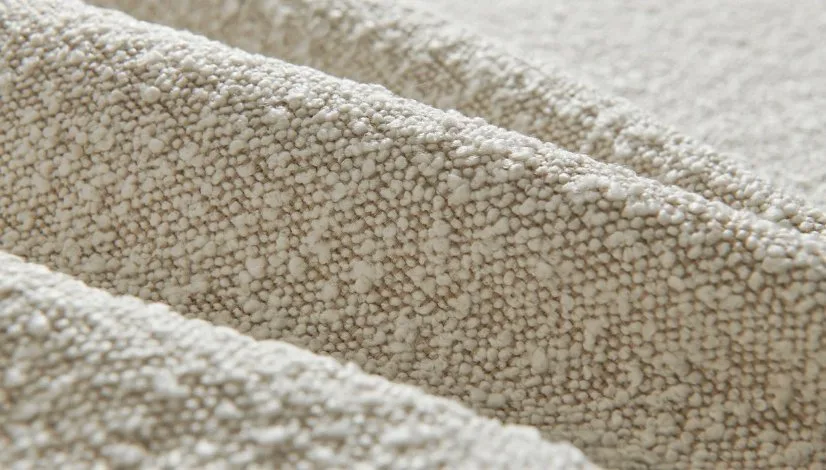Everything You Need to Know About This Trending Upholstery and Fashion Fabric
Boucle fabric has taken over design feeds, furniture showrooms, and fashion runways in 2025. This textured material with its signature looped surface creates a cozy yet sophisticated look that works in both modern homes and classic wardrobes. But what exactly is boucle, and is it right for your next project?
You’ll find answers to every question about boucle in this guide, from its rich history with Coco Chanel to whether it can survive your cat’s claws. We’ll cover pricing, durability, maintenance, and help you decide if this trendy fabric deserves a place in your space.
Table of Contents
- What is Boucle Fabric?
- How to Pronounce Boucle
- Historical Heritage: From Chanel to Mid-Century Modern
- How Boucle is Made
- Types and Fiber Blends
- Boucle vs Other Fabrics
- Fashion Applications
- Upholstery and Interior Design
- The Pet Question: Cats, Dogs & Boucle
- Durability and Performance
- Maintenance and Care
- Pricing Guide
- How to Identify Quality Boucle
- Boucle in 2025: Current Trends
- Sustainability Considerations
- Buying Guide
- Frequently Asked Questions
What is Boucle Fabric?
Boucle (pronounced “boo-CLAY”) is a textured fabric known for its distinctive looped or curled surface. The name comes from the French word “boucler,” which means “to curl” or “to loop,” perfectly describing this material’s signature bumpy, three-dimensional appearance.
How Do You Pronounce Boucle?
Say it like “boo-CLAY” with the emphasis on the second syllable. The accent on the “e” (bouclé) indicates this French pronunciation, though many English speakers simply say “boo-klay” or “book-lay” and both are widely accepted.
What Kind of Fabric is Boucle?
Technically, boucle refers to both a type of yarn and the fabric made from it. The yarn itself features loops of varying sizes created during the spinning process, which then get woven into fabric. This makes boucle a woven textile rather than a knit, though the texture can sometimes fool you into thinking otherwise.
Quick Definition: Boucle is a woven fabric made with specialty looped yarn that creates a nubby, textured surface. It can be made from natural fibers like wool and cotton, synthetic materials like polyester, or blends of both.
Historical Heritage: From Chanel to Mid-Century Modern
Boucle’s story weaves through both fashion and furniture design, marking some of the most memorable moments in 20th-century style.
Coco Chanel and the Boucle Revolution
In the early 1950s, Coco Chanel discovered boucle fabric through a textile merchant and immediately recognized its potential. She was searching for materials that were comfortable yet looked expensive, and boucle fit perfectly. Chanel used this fabric to create her now-legendary collarless jacket and skirt suits, which revolutionized women’s fashion by offering freedom of movement while maintaining elegance.
One of Chanel’s favorite suppliers was Linton Tweeds, a Scottish mill that began providing fabrics for her collections in 1928 and continues to supply Chanel to this day.
Jackie Kennedy’s Pink Boucle Suit
Boucle fabric became permanently part of cultural memory when Jackie Kennedy wore a pink Chanel boucle suit on November 22, 1963, the day President John F. Kennedy was assassinated. That heartbreaking moment cemented boucle’s place in fashion history and made the fabric recognizable to millions who might never have noticed it otherwise.
The Womb Chair: Boucle in Furniture Design
While Chanel was transforming fashion, boucle was also making waves in furniture. In 1946, Florence Knoll asked her friend, designer Eero Saarinen, to create “a chair that was like a basket full of pillows, something I could really curl up in.”
Saarinen’s response became the iconic Womb Chair, released in 1948. The chair’s revolutionary molded fiberglass shell was upholstered in boucle fabric, making it one of the first major furniture pieces to showcase this textile. The combination of the chair’s organic shape and boucle’s cozy texture created a design that’s still in production more than 75 years later.
How Boucle is Made
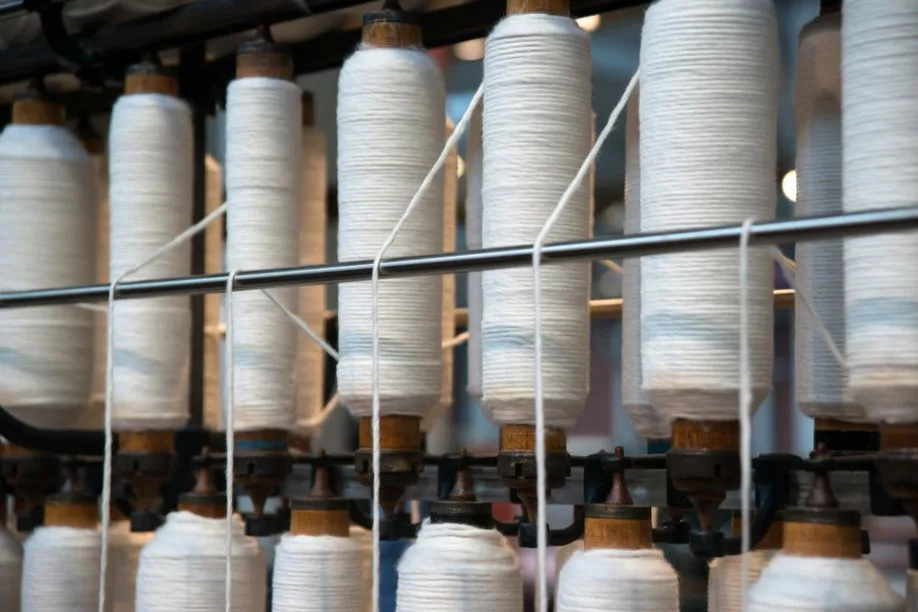
Understanding how boucle gets its signature texture helps explain both its appeal and its care requirements.
The Yarn Creation Process
Boucle starts with its namesake yarn. Manufacturers combine at least two strands of fiber during spinning. Here’s the clever part: one strand stays tight and acts as the core, while the second strand is given much more slack. As these strands twist together, the looser strand naturally forms loops along the tighter core strand.
The size and frequency of these loops can vary dramatically, from tiny tight curls to large, loose circles. This variation creates different textures and looks in the final fabric.
Weaving the Fabric
Once the looped yarn is ready, it gets woven into fabric using traditional weaving techniques. Some boucles use looped yarn for both the warp (lengthwise threads) and weft (crosswise threads), creating an all-over texture. Others might use standard yarn for the base and boucle yarn as accents, producing a more subtle effect.
The weaving pattern affects durability. Tighter weaves with the loops locked into place tend to last longer and resist snagging better than looser constructions.
Is Boucle a Knit or a Weave?
Boucle is a woven fabric, not a knit. The confusion comes from its soft, textured appearance that can look similar to knitted materials. However, boucle uses the over-under interlacing pattern of weaving, which actually makes it more stable and durable than most knit fabrics.
Types and Fiber Blends
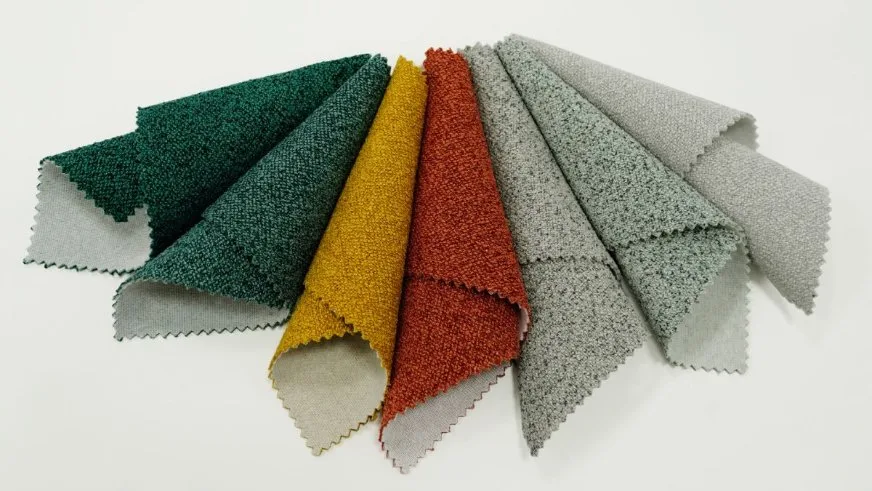
Is Boucle Natural or Synthetic?
Boucle can be either natural, synthetic, or a blend of both. The fiber content dramatically affects the fabric’s performance, price, and feel.
Natural Fiber Boucles
- Wool boucle: The traditional choice, offering natural warmth, fire resistance, and breathability. Wool boucle is particularly popular for fashion applications and upholstery in cooler climates.
- Cotton boucle: Lighter and more breathable than wool, making it suitable for warmer weather applications. Often blended with polyester for added durability.
- Silk boucle: Rare and expensive, with a luxurious sheen. Mostly used in high-end fashion rather than upholstery.
- Alpaca and mohair blends: Extremely soft and warm, these premium options appear in luxury fashion pieces.
Synthetic and Blended Options
- Polyester boucle: More affordable and easier to care for than natural options. Better stain resistance and color retention make it popular for commercial spaces.
- Acrylic boucle: Mimics wool’s appearance at a lower price point. Can include recycled content for more sustainable options.
- Wool-polyester blends: Combine the best of both worlds, offering wool’s natural beauty with polyester’s practicality and durability.
Performance Tip: Higher synthetic content increases abrasion resistance, making these blends better for heavy-use areas. Natural fiber dominance offers better breathability and comfort for items that touch your skin directly.
Is Boucle Made of Wool?
Traditional boucle was made primarily from wool, and many premium boucles still are. However, modern boucle comes in many fiber compositions. When shopping, always check the content label. A “wool boucle” should have at least 80% wool content, while blends will list all fiber percentages.
Is Boucle Wool Good Quality?
Yes, wool boucle represents high quality when made well. Wool provides natural benefits like temperature regulation, flame resistance, and durability. Quality wool boucle should feel soft without being scratchy, have consistent loop sizes, and show no loose threads or weak spots in the base weave.
Boucle vs Other Fabrics
How does boucle stack up against other popular upholstery and fashion fabrics? This comparison helps you make informed decisions for your projects.
| Fabric | Durability | Pet-Friendly | Price Range | Maintenance |
|---|---|---|---|---|
| Boucle | High (50,000-100,000+ cycles) | Debated (see below) | $15-150/yard | Moderate |
| Velvet | Medium (25,000-50,000 cycles) | Low | $20-100/yard | High |
| Linen | Medium (30,000-50,000 cycles) | High | $15-80/yard | Low |
| Microfiber | Very High (100,000+ cycles) | Very High | $10-40/yard | Very Low |
| Leather | High (varies) | Medium | $30-200/sq ft | Medium-High |
Is Boucle Better Than Velvet?
Neither fabric is objectively “better” – they serve different purposes. Boucle wins for durability, practical maintenance, and hiding wear patterns. The textured surface disguises minor damage and shows fewer vacuum marks or sitting impressions.
Velvet offers a more formal, luxurious appearance with its smooth pile and subtle sheen. However, it shows every mark, requires more careful cleaning, and wears down faster in high-traffic areas.
Choose boucle if you want: Durability, low-maintenance care, texture mixing in your design, and a casual-meets-sophisticated vibe.
Choose velvet if you want: High glamour, smooth texture, rich color depth, and formal elegance (and can commit to the maintenance).
Is Tweed the Same as Boucle?
No, though they’re related. Tweed is a rough-textured woven fabric, typically made from wool, with a visible pattern created by different colored yarns. Boucle uses looped yarn to create its texture.
The confusion comes from Coco Chanel, who worked with both tweeds and boucles, sometimes calling her fabrics “buckled tweed” or “boucle tweed” when they combined characteristics of both textiles.
What Fabric is Similar to Boucle?
If you like boucle’s textured look but want alternatives, consider:
- Teddy fabric: Similar plush feel with a more uniform, fleece-like surface
- Sherpa: Fluffy texture that’s often more affordable
- Textured chenille: Soft and velvety with some surface interest
- Nubby linen: Natural texture without loops, easier to maintain
What Fabric is Like Velvet But Cheaper?
If you want velvet’s luxurious look without the price tag, several alternatives deliver similar aesthetics:
- Microfiber or microsuede: Soft, smooth surface that mimics velvet’s appearance at $10-25/yard. Much easier to maintain and more durable.
- Polyester velvet: Real velvet made from synthetic fibers costs less than silk or cotton velvet while offering better stain resistance.
- Crushed velvet: The textured surface hides imperfections, making lower-quality versions look better than flat velvet.
- Velour: Knitted rather than woven, velour costs less and stretches more, though it lacks velvet’s refined drape.
What is the Best Material for a Couch?
The “best” upholstery fabric depends entirely on your household needs. Here’s how different situations match with fabrics:
For families with young children: Microfiber or performance fabrics win. They resist stains, clean easily, and hide damage well.
For pet owners: Tight-weave performance fabrics or leather work better than boucle. Look for scratch-resistant synthetics or leather that develops character as it ages.
For formal living rooms with light use: Silk, linen, or velvet create sophisticated looks when durability isn’t the priority.
For everyday comfort and style: Boucle offers an excellent balance of durability, aesthetics, and comfort for households without destructive pets.
For maximum durability: Commercial-grade synthetic blends tested to 100,000+ double rubs outlast everything else.
What is the Most Itchy Fabric?
The scratchiest fabrics typically include:
- Cheap wool: Coarse, low-quality wool with short fibers feels notoriously scratchy
- Burlap and jute: Natural plant fibers that are stiff and rough by design
- Horsehair fabric: Used in tailoring but extremely coarse against skin
- Sisal: Another plant fiber that’s intentionally rough
- Cheap acrylic: Lower-quality synthetic versions can feel prickly and uncomfortable
Quality boucle shouldn’t appear on this list. Well-made boucle, especially in cotton, soft wool, or synthetic blends, feels comfortable rather than scratchy.
Fashion Applications
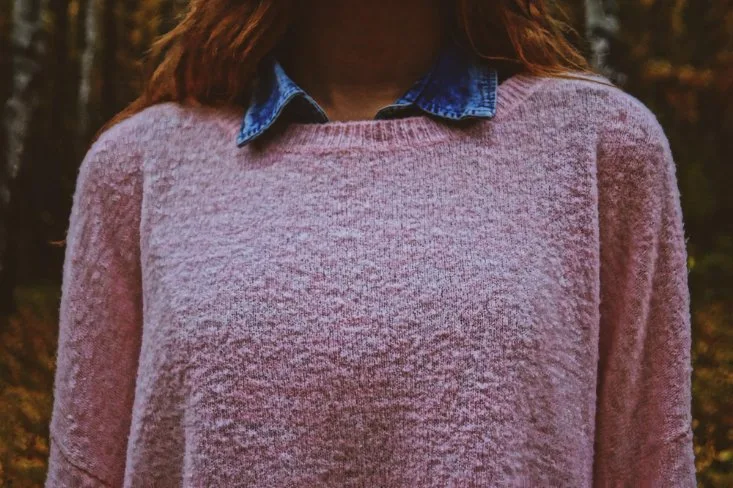
While boucle furniture dominates design magazines in 2025, this fabric’s fashion roots run deep.
Classic Fashion Uses
Boucle excels in structured garments where its body and texture add visual interest:
- Jackets and blazers: The classic Chanel-style boucle jacket remains timeless. The fabric’s structure helps jackets hold their shape without heavy interfacing.
- Coats: Boucle’s warmth and wind resistance make it perfect for outerwear, especially in wool blends.
- Skirts and dresses: The texture adds dimension without bulk, though these pieces require careful sewing techniques.
- Suits: Matching jacket and skirt or pants create polished professional looks.
Is Boucle a Summer or Winter Fabric?
Boucle works for both seasons, depending on fiber content:
Winter boucle: Wool and wool-blend boucles provide excellent insulation. The loops trap air, creating natural warmth. These heavier weights (typically 12-18 oz per yard) suit coats, blazers, and cold-weather applications.
Summer boucle: Lightweight cotton, linen, or silk boucles work for warmer months. These breathable options (6-10 oz per yard) appear in unlined jackets, dresses, and accessories. The texture adds visual interest without adding warmth.
For summer fabrics in general, you want breathability and light weight. Cotton or linen boucle fits the bill, while heavy wool versions definitely belong in the winter fabric category.
Which Fabric is Not Suitable for Summer?
Avoid these fabrics in hot weather:
- Heavy wool: Traps heat and doesn’t breathe well
- Polyester blends without moisture-wicking: Can feel sweaty and uncomfortable
- Thick fleece or flannel: Designed for warmth, unbearable in heat
- Non-breathable synthetics: Trap moisture against your skin
- Heavy denim: Dense weave plus cotton weight equals overheating
Wool boucle falls into this category for summer clothing, though lightweight cotton or linen boucle can work fine.
What is the Most Comfortable Fabric for Hot Weather?
The coolest, most comfortable fabrics for hot weather include:
- Linen: Natural plant fiber that breathes exceptionally well and wicks moisture
- Lightweight cotton: Especially cotton voile, lawn, or chambray
- Bamboo fabric: Silky, breathable, and naturally moisture-wicking
- Silk: Lightweight and temperature-regulating (though requires special care)
- Performance synthetics: Modern moisture-wicking fabrics designed for athletic wear
- Lightweight linen-cotton blends: Combine linen’s breathability with cotton’s softness
Cotton or linen boucle can work for hot weather if you choose lightweight versions, but smoother weaves generally feel cooler since textured surfaces trap more heat.
Sewing with Boucle
Boucle presents unique challenges for home sewers:
- The looped surface makes marking and measuring difficult
- Loose weaves can fray extensively, requiring extra seam allowances
- Pattern pieces need careful cutting to avoid disturbing loops
- Professional finishing like bound seams or French seams help prevent unraveling
Budget extra fabric when working with boucle. You’ll need to account for pattern matching, securing edges, and the inevitable waste from its tendency to fray.
Watch & Learn: See boucle fabric in action with this detailed sewing tutorial showing how to create a cozy dress with boucle fabric.
Upholstery and Interior Design
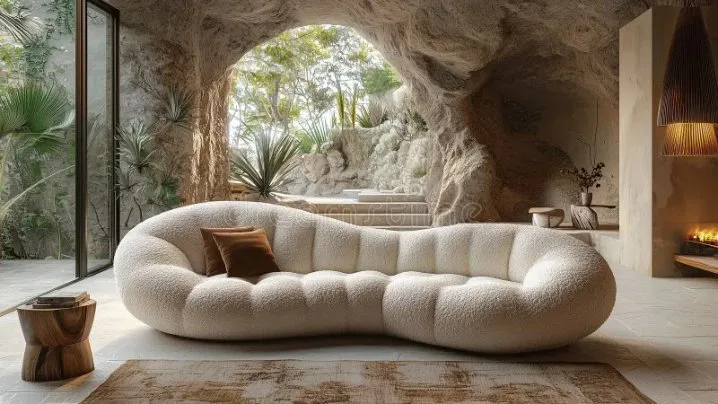
Boucle has become the go-to upholstery fabric for creating spaces that feel both stylish and welcoming.
Where Boucle Shines in Your Home
Living Spaces
Boucle sofas and sectionals anchor living rooms with their soft texture and dimensional appearance. The fabric catches light differently throughout the day, creating visual interest without patterns or prints. Accent chairs in boucle add cozy seating spots perfect for reading or conversation.
Bedrooms
Boucle upholstered headboards bring warmth to bedrooms. The padded, textured surface creates a comfortable backrest for reading in bed while adding a hotel-like luxury feel to the room.
Commercial Spaces
Hotels, restaurants, and offices choose boucle for its durability in high-traffic areas. The texture hides wear better than smooth fabrics, keeping furniture looking fresh longer. Reception seating, waiting areas, and restaurant banquettes all benefit from boucle’s combination of comfort and longevity.
Is Boucle a Good Fabric for a Bed?
Boucle works wonderfully for bed frames and headboards. The soft, padded texture feels pleasant to lean against, and the fabric adds warmth to bedroom design. However, consider these factors:
Pros for beds:
- Comfortable to lean against for reading or watching TV
- Adds textural interest to bedroom design
- Works with many decorating styles from modern to traditional
- Relatively easy to keep clean in this low-contact application
Cons to consider:
- Loops can collect dust (requires regular vacuuming)
- Hair and lint may get caught in the texture
- Light colors show dirt more readily in bedrooms
- May attract pets who enjoy textured surfaces
Design Tips for Using Boucle
Balance texture in your space. Boucle pairs beautifully with:
- Smooth surfaces: Glass coffee tables, marble side tables, or glossy wood finishes create contrast
- Metal accents: Brass, chrome, or matte black metal frames look sophisticated against boucle’s organic texture
- Natural materials: Wood, linen, jute, and leather complement boucle’s cozy vibe
- Smooth fabrics: Silk pillows, cotton throws, or velvet accents prevent texture overload
The Pet Question: Cats, Dogs & Boucle
This topic divides designers, pet owners, and fabric experts. You’ll find passionate arguments on both sides.
The Controversy: Some sources claim boucle resists pet damage beautifully, while others insist it’s a disaster with claws. The truth depends on several factors, and we’ll help you navigate this confusing landscape.
Do Cats Scratch Boucle Fabric?
Yes, cats will scratch boucle – and here’s where it gets interesting. The effect depends on boucle quality and your cat’s scratching style.
The case for boucle with cats: The looped texture can actually hide minor damage. When a claw catches a loop, it may pull it slightly but not create an obvious hole or run like it would in woven fabrics. Some cat owners report their boucle furniture shows no visible damage even after years of use.
The case against boucle with cats: Cats are naturally attracted to boucle’s texture because those loops provide excellent scratching satisfaction. If your cat uses furniture as a scratching post, they can pull loops loose, creating an increasingly shabby appearance. Once a loop gets pulled, it can unravel further with each scratch.
Is Boucle Dog Friendly?
Dogs present different challenges than cats. They typically scratch less destructively but bring other concerns:
Good news for dog owners:
- Dogs don’t usually scratch furniture with the same intensity as cats
- The textured surface hides dog hair better than smooth fabrics
- Digging or pawing at cushions causes less visible damage to boucle than to tightly woven fabrics
Challenges with dogs:
- Large dogs’ nails can catch and pull loops when jumping on/off furniture
- Drool, mud, and wet paws show more on light-colored boucle
- Hair gets tangled in loops and requires more effort to remove
Making Boucle Work with Pets
If you love boucle and have pets, try these strategies:
- Choose high-quality, tightly woven boucle: Cheaper, loosely woven options unravel more easily
- Select synthetic or synthetic-blend boucle: These resist damage better than pure natural fibers
- Go with medium to dark colors: They hide fur and dirt more effectively
- Provide alternative scratching surfaces: Give cats appealing scratching posts or pads near boucle furniture
- Keep nails trimmed: Shorter claws cause less damage to any fabric
- Use washable covers or throws: Protect high-contact areas and wash them regularly
- Train pets to stay off furniture: If that works for your household dynamic
The Verdict: Boucle can work with pets, but it’s not the most pet-proof option. If you have destructive scratchers or very active pets, consider microfiber or tight-weave performance fabrics instead. For calmer pets or pet owners willing to provide good scratching alternatives, quality boucle can survive reasonably well.
Durability and Performance
Does Boucle Fabric Hold Up Well?
Quality boucle offers excellent durability when properly made and maintained. The fabric’s performance depends on several factors:
Abrasion Resistance
Furniture industry testing measures durability in “double rubs” or Martindale cycles. This test rubs fabric with a standardized material to simulate years of use.
- Residential boucle: 50,000+ cycles (suitable for normal home use)
- Commercial-grade boucle: 100,000+ cycles (handles heavy traffic in hotels, offices, restaurants)
For comparison, your average cotton fabric might test at 15,000-30,000 cycles. Boucle’s structure makes it genuinely tough.
Why Boucle Lasts
The looped construction acts like a shock absorber. Each loop distributes pressure across multiple contact points rather than stressing single threads. This design means:
- Sitting pressure spreads across the fabric’s surface
- Individual loops can take damage without compromising the whole fabric
- The three-dimensional structure bounces back after compression
- Wear patterns develop more slowly than on flat weaves
Does Boucle Pill Easily?
Pilling (those little fabric balls that form from friction) depends entirely on fiber content:
Low-pilling boucles: Wool, acrylic, and quality polyester blends resist pilling well. The loops themselves are less prone to pilling than fuzzy surfaces like fleece.
Higher-pilling risk: Cotton boucles and lower-quality synthetic blends may develop some pills with heavy use, particularly in high-friction areas like seat cushions and armrests.
Most boucles rate Grade 4-5 on the ASTM D3511 pilling scale (where Grade 5 means no pilling). This makes boucle one of the better-performing fabrics for pilling resistance.
Is Boucle High Maintenance?
Boucle sits in the moderate maintenance category – easier than velvet or silk, more involved than microfiber or leather.
Regular care:
- Weekly vacuuming with upholstery attachment
- Immediate spot cleaning of spills
- Monthly rotation of cushions to distribute wear
Occasional needs:
- Professional cleaning every 6-12 months for upholstery
- Trimming loose threads with sharp scissors
- Steam cleaning for deep refreshing
Maintenance and Care
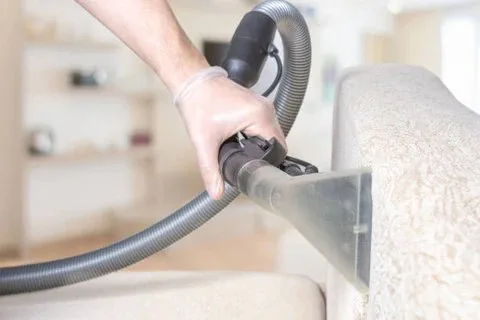
Does Boucle Get Dirty Easily?
The textured surface is both friend and foe. Those loops can trap dirt, dust, and pet hair more readily than smooth fabrics. However, the same texture also hides light soiling better than smooth weaves, so your furniture looks cleaner longer between deep cleans.
Light-colored boucle shows dirt more obviously, while medium to dark shades disguise normal household dust and debris.
Do Boucle Beds Get Dirty?
Boucle headboards and bed frames collect dust in their loops, requiring regular vacuuming. They’re not dramatically harder to maintain than other upholstered beds, but the texture does catch and hold particles more than smooth leather or linen would.
Is Boucle Hard to Clean?
Cleaning boucle requires a lighter touch than some fabrics but isn’t difficult once you know the approach.
Regular Maintenance
- Vacuum weekly: Use your vacuum’s upholstery attachment with gentle suction. Avoid beater bars that can catch and pull loops
- Brush carefully: A soft fabric brush removes surface dust without damaging loops
- Rotate and flip: Move cushions weekly to prevent uneven wear and fading
Spot Cleaning Spills
Act within 15 minutes for best results:
- Blot (never rub) with clean, white microfiber cloths
- Work from the outside of the stain inward to prevent spreading
- Use pH-neutral cleaners designed for upholstery
- Dab cleaning solution onto a cloth first, then onto the stain
- Rinse by dabbing with clean water
- Air dry completely – never use heat
Never do this to boucle: Don’t use stiff brushes, harsh scrubbing motions, or high heat. These can pull loops loose, damage fibers, or cause permanent fabric distortion.
Can I Steam Clean Boucle?
Yes, steam cleaning works well for boucle upholstery. The low-moisture heat lifts dirt without saturating the fabric. Professional upholstery cleaning typically uses steam or low-moisture extraction methods specifically because they’re safe for textured fabrics like boucle.
If using a home steam cleaner, test on an inconspicuous area first, keep the steam head moving (don’t hold it in one spot), and allow thorough air drying after cleaning.
Does Boucle Get Dusty?
Yes, more than smooth fabrics. The loops create tiny pockets where dust settles and accumulates. Regular vacuuming (weekly in high-use areas, bi-weekly elsewhere) prevents buildup. In dusty environments or homes with pets, you might notice dust collecting in the texture more quickly.
Caring for Boucle Clothing
Fashion items require different care than upholstery:
- Dry clean preferred: Most boucle garments, especially wool ones, perform best with professional dry cleaning
- Hand washing exceptions: Cotton and cotton-blend boucles sometimes tolerate gentle hand washing in cold water
- Never tumble dry: Heat can shrink natural fibers and damage the loop structure
- Store carefully: Hang structured pieces like jackets; fold looser items to prevent stretching
For comprehensive guidance on caring for different textiles, check our fabric care guide.
Pricing Guide
Boucle fabric pricing varies dramatically based on fiber content, quality, and where you purchase it.
Budget-Friendly
$15-30/yard
- Polyester or acrylic blends
- Basic weave patterns
- Limited color selection
- Suitable for accent pieces
Mid-Range
$30-70/yard
- Wool-poly blends
- Better construction quality
- Commercial durability ratings
- Good color variety
Premium
$70-150+/yard
- High wool content or natural fibers
- Designer brands
- Complex textures and patterns
- Superior durability and hand-feel
Is Boucle High End?
Boucle has a luxury reputation thanks to Chanel, but accessibility has changed dramatically. In 2025, you can find quality boucle at various price points.
The fabric occupies an interesting middle ground – it looks expensive and sophisticated even at lower price points. A $25/yard polyester boucle can deliver the high-end aesthetic people associate with Chanel, even if the fiber content doesn’t match couture standards.
Premium boucles from specialized textile houses or those matching Chanel’s specifications definitely count as high-end materials. But the general availability of boucle-look fabrics means the aesthetic is now accessible to everyone.
Factors Affecting Boucle Prices
- Fiber content: Natural fibers cost more than synthetics
- Construction quality: Tighter weaves with secure loops command higher prices
- Brand reputation: Designer mills like Linton Tweeds charge premium rates
- Performance treatments: Stain-resistant or eco-friendly finishes add cost
- Width: Wider fabrics (60″ vs. 54″) typically cost more per yard but provide better value
- Origin: European-made boucles often price higher than Asian-manufactured options
Cost Comparison: Boucle vs. Alternatives
How does boucle pricing compare to similar fabrics?
- Velvet: Similar price range ($20-100/yard), but performance velvet costs more
- Quality linen: Comparable for mid-range options ($20-80/yard)
- Wool tweed: Often more expensive ($40-120/yard) for similar quality
- Microfiber: Much cheaper ($10-40/yard) for similar durability
How to Identify Quality Boucle
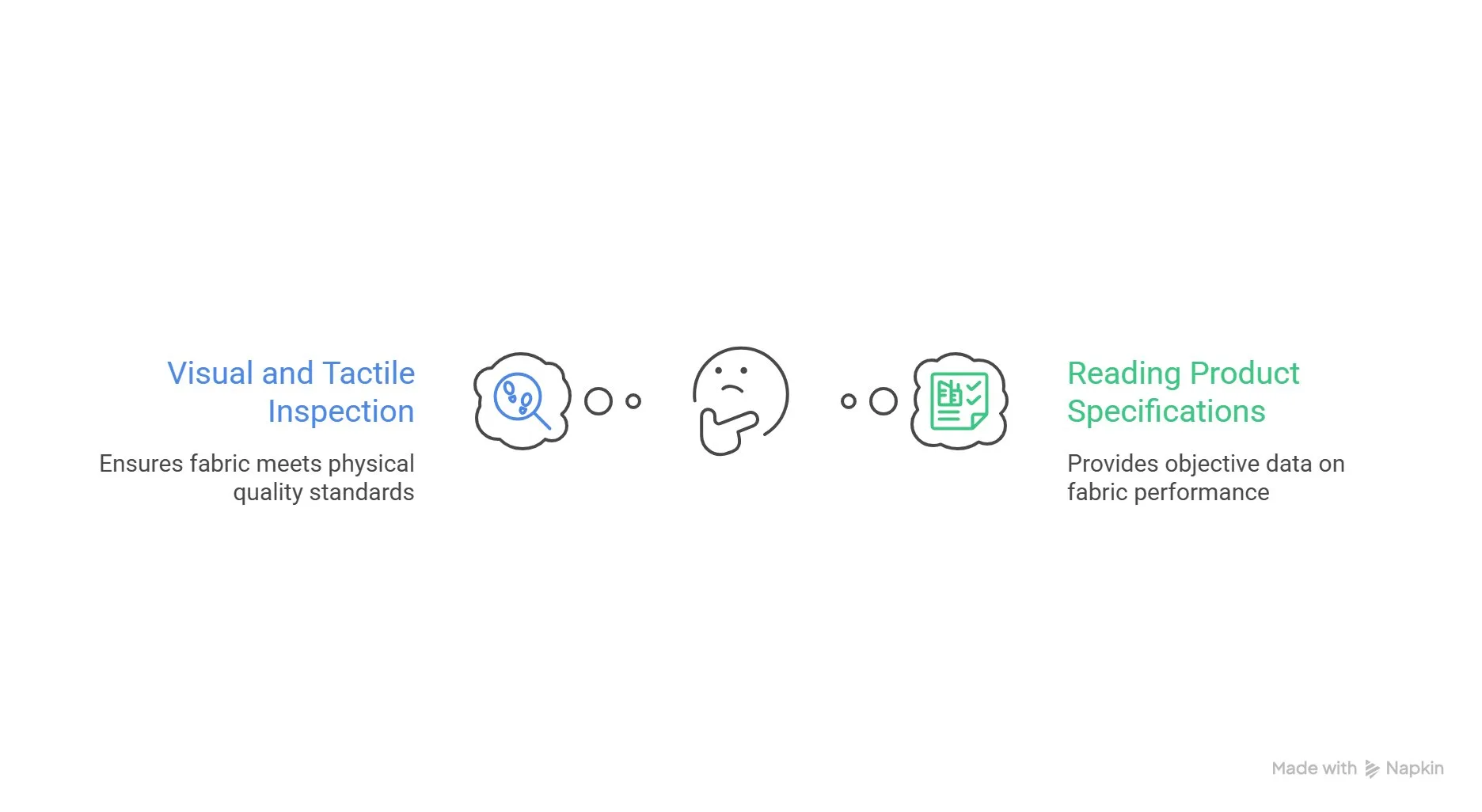
Not all boucle is created equal. These signs help you spot well-made fabric worth your investment.
Visual and Tactile Inspection
Look For:
- Consistent loop sizes: Quality boucle has relatively uniform loops across the surface
- Secure loop attachment: Gently tug a few loops – they should stay firmly attached
- Tight base weave: Hold fabric up to light – you shouldn’t see large gaps between threads
- Even color saturation: Dye should penetrate loops completely with no pale or streaky areas
- Minimal shedding: Rub the surface – quality boucle releases few fibers
- Good hand feel: The fabric should feel substantial without being stiff or scratchy
Red Flags:
- Loose loops that pull away easily
- Visible backing fabric through the loops
- Excessive lint or fiber shedding when handled
- Irregular or splotchy color
- Chemical smell (indicates poor-quality dyes or finishes)
- Weak, flimsy backing that tears easily
Reading Product Specifications
When shopping online or reviewing product information:
- Check Martindale ratings: 50,000+ for residential, 100,000+ for commercial
- Read fiber content carefully: Higher percentages of quality fibers indicate better performance
- Look for certifications: OEKO-TEX Standard 100 ensures fabrics are tested for harmful substances
- Note the weight: Heavier fabrics (14-18 oz/yard) typically offer more durability
- Research the manufacturer: Established textile mills generally maintain better quality control
Boucle in 2025: Current Trends
Is Boucle Still in Style in 2025?
Yes, emphatically. Boucle is experiencing peak popularity in 2025, appearing everywhere from high-end furniture showrooms to fast-fashion home stores. The trend shows no signs of fading.
Is Boucle Going Out of Fashion?
While nothing stays trendy forever, boucle has strong staying power. Unlike purely aesthetic trends that come and go, boucle offers practical benefits that keep it relevant:
- Genuine comfort and durability
- Versatility across design styles
- 75+ year history in design
- Adaptability to changing color palettes and shapes
Think of boucle like denim or leather – it may have peak popularity moments, but it never fully disappears because it serves real functional purposes beyond just looking good.
Why is Boucle So Popular?
Several factors drive boucle’s current popularity:
- Social media influence: Instagram and Pinterest overflow with #bouclefurniture photos that drive consumer desire
- Comfort prioritization: Post-2020, people increasingly value cozy, welcoming homes over formal showpieces
- Texture mixing trend: Current 2025 design trends emphasize layering different textures – boucle plays perfectly into this
- Improved affordability: Quality boucle at accessible prices means more people can participate in the trend
- Vintage appeal: Mid-century modern style remains influential, and boucle ties directly to that aesthetic
Color Trends in Boucle
2025 sees these color directions in boucle:
- Neutrals dominate: Off-whites, creams, oatmeal, and soft grays remain most popular
- Warm earth tones: Terracotta, camel, rust, and clay colors complement natural color palettes
- Muted greens: Sage, olive, and moss tones appeal to buyers seeking organic, nature-inspired spaces
- Statement blacks: Black boucle adds dramatic contrast in contemporary spaces
Design Applications in 2025
How people use boucle is evolving:
- Full boucle sectionals: Large-scale seating in boucle creates statement pieces
- Mix-and-match: One boucle chair paired with a smooth sofa adds interest without overwhelming
- Unexpected applications: Boucle appearing on dining chairs, ottomans, and even as accent walls
- Layered textures: Boucle furniture with linen curtains, jute rugs, and leather accents creates sophisticated, tactile spaces
Sustainability Considerations
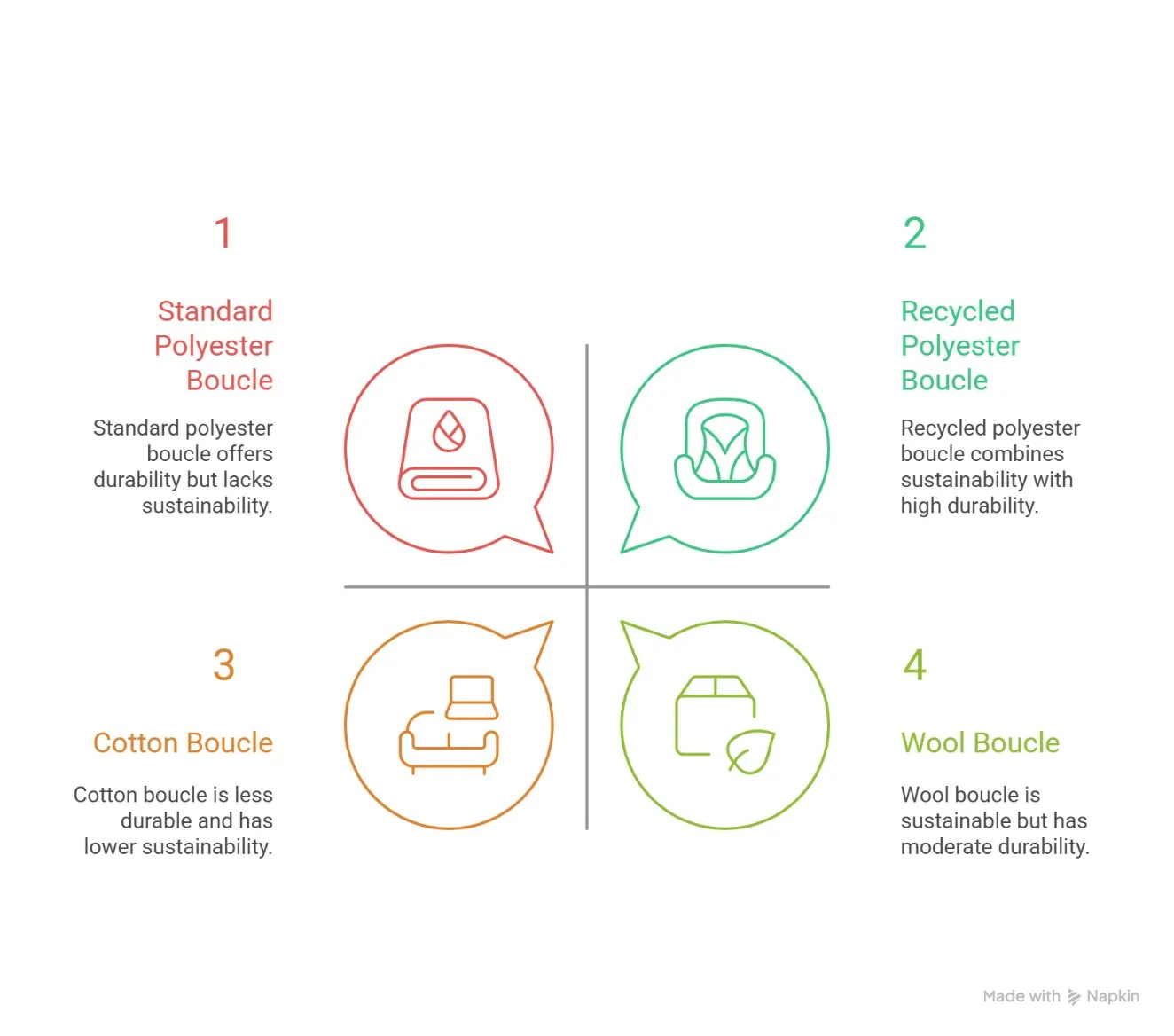
As consumers become more environmentally conscious, boucle’s sustainability profile matters.
Environmental Impact by Fiber Type
Natural Fiber Boucles
Wool: Renewable and biodegradable, wool has a relatively low environmental impact when sourced responsibly. Look for certifications like Responsible Wool Standard (RWS) to ensure ethical farming practices.
Cotton: More water-intensive than wool. Organic cotton boucles offer a more sustainable option, avoiding pesticides and using less water.
Synthetic Options
Recycled polyester: Some manufacturers now offer boucle made from recycled plastic bottles or reclaimed polyester. This reduces new petroleum use and diverts waste from landfills.
Standard polyester: Derived from petroleum, traditional polyester has a higher carbon footprint but offers exceptional durability, meaning fewer replacements over time.
Longevity as Sustainability
One of boucle’s strongest environmental credentials is its durability. A well-made boucle sofa can last 15-20 years or more, compared to 5-7 years for fast-furniture alternatives. This “buy once, use for decades” approach reduces overall consumption and waste.
Does Boucle Shed Microfibers?
All fabrics shed some fibers, which can enter air and water as microplastics (for synthetics) or organic matter (for natural fibers). Boucle sheds minimally compared to fleece, chenille, or sherpa fabrics because its loops are secured within the weave rather than relying on a fuzzy pile that constantly releases fibers.
Eco-Friendly Boucle Options
If sustainability matters to you, look for:
- OEKO-TEX Standard 100 certification (no harmful chemicals)
- Global Organic Textile Standard (GOTS) for organic fibers
- Cradle to Cradle certification
- Recycled content labeling
- Local or domestic manufacturing to reduce shipping emissions
Buying Guide
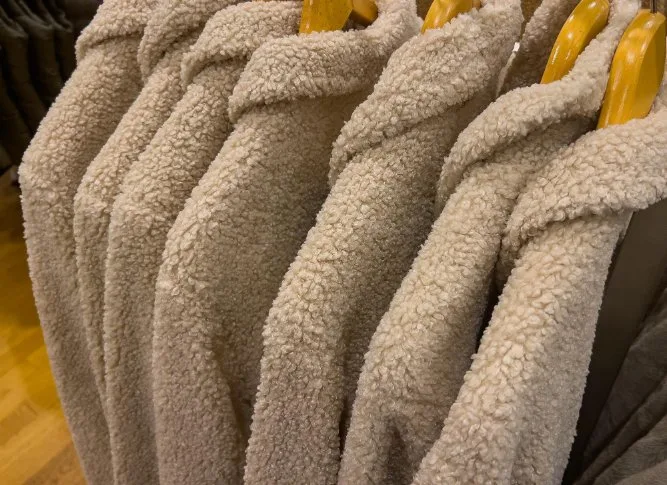
Where to Buy Boucle Fabric
Multiple sources offer boucle by the yard:
Fabric Retailers
- Specialty fabric stores: Best selection and expert guidance, but typically higher prices
- Online fabric retailers: Wider selection and competitive pricing; many offer samples
- Upholstery suppliers: Focus on durable, furniture-grade boucles with commercial ratings
- Fashion fabric shops: Better for clothing-weight boucles, often have designer options
Furniture with Boucle Upholstery
- Direct-to-consumer brands: Companies like Article, Interior Define, and Burrow offer good quality at reasonable prices
- High-end furniture stores: Expect premium prices but excellent quality and service
- Mass-market retailers: More affordable but quality varies significantly
Before You Buy: Boucle Checklist
Ask yourself these questions:
- What’s your primary use? High-traffic furniture needs commercial-grade ratings
- Do you have pets? Consider quality, color, and alternative scratching surfaces
- What’s your climate? Hot climates might prefer cotton or linen boucle; cold areas suit wool
- How much maintenance can you handle? Light colors and textured fabrics need more care
- What’s your budget? Be realistic about fiber content and quality you can afford
- Does it match your style? Boucle works in many aesthetics but isn’t universal
Ordering Fabric Yardage
When buying boucle by the yard for upholstery projects:
- Order samples first: See color, texture, and weight in person before committing
- Calculate carefully: Factor in pattern repeats (if any) and extra for cushions or errors
- Add 10-15% extra: Boucle’s texture can make cutting and matching more difficult
- Check return policies: Some retailers don’t accept returns on cut yardage
- Ask about dye lots: Order all fabric from the same dye lot to ensure color consistency
Many fabric suppliers now offer flexible ordering without minimum quantities, making custom projects more accessible. Use tools like a fabric yardage calculator to determine exactly how much you need.
Frequently Asked Questions
Is boucle itchy?
Good quality boucle should not feel itchy. Wool boucle is softer than scratchy wool sweaters because the loops create space between the fiber and your skin. However, low-quality wool or certain coarse natural fiber blends may feel slightly prickly. Synthetic boucles like polyester rarely cause itchiness. If you have sensitive skin, choose cotton, cotton-blend, or soft acrylic boucles, or test a sample against your skin before purchasing.
Is boucle warm or cool?
Boucle’s temperature depends on fiber content. Wool boucle provides warmth and insulation, making it perfect for winter jackets and cozy furniture. Cotton and linen boucles breathe better and feel cooler, suitable for year-round use. Synthetic boucles tend to be temperature-neutral. For upholstery, most people find boucle comfortable in all seasons because you’re not wearing it directly against your skin for extended periods.
Is boucle material good?
Yes, boucle is an excellent material choice for both furniture and fashion. It offers high durability (50,000-100,000+ double rubs), resists pilling, hides minor wear, and provides a sophisticated aesthetic. The fabric’s longevity justifies its cost, often lasting 15-20 years in upholstery applications. Boucle combines visual interest with practical performance, making it a smart investment for pieces you’ll use frequently.
What exactly is boucle fabric?
Boucle is a woven textile made from specialty looped yarn. During manufacturing, at least two threads are twisted together with one kept loose, creating loops along a tighter core thread. These looped yarns are then woven into fabric, producing the characteristic bumpy, three-dimensional texture. Boucle can be made from wool, cotton, linen, silk, synthetic fibers, or blends.
What does the French word boucle mean?
Boucle comes from the French verb “boucler,” meaning “to curl” or “to loop.” The name directly describes the fabric’s defining feature – those curled loops that create its textured surface. The term appeared in English textile vocabulary in the mid-20th century as the fabric gained popularity in fashion and design.
What is the difference between knit and boucle?
Boucle is a woven fabric, not a knit. Knits are made by interlocking loops of yarn in rows, creating a stretchy, flexible material. Boucle uses the over-under interlacing of weaving, which makes it more stable and less stretchy than knits. The confusion arises because boucle’s looped texture can visually resemble knitted fabrics, but the construction methods are completely different. Boucle’s woven structure makes it more durable and better suited for upholstery than most knits.
What are the disadvantages of boucle fabric?
Boucle’s main drawbacks include: loops that can snag on jewelry, pet claws, or rough surfaces; tendency to collect dust and pet hair in the texture; higher cost than smooth synthetic fabrics; requires more careful cleaning than microfiber; potential for pulled loops if not handled carefully; and light colors show dirt more readily. For fashion sewing, boucle also presents challenges with fraying edges and requires more fabric for projects.
Does boucle and velvet go together?
Yes, boucle and velvet pair beautifully in interior design. The contrast between boucle’s nubby texture and velvet’s smooth pile creates visual interest and tactile variety. Try a boucle sofa with velvet throw pillows, or mix a velvet chair with a boucle ottoman. Keep the color palette coordinated (either complementary or tonal) to prevent the textural mix from looking chaotic. This combination works particularly well in contemporary and transitional design styles.
What are the benefits of boucle fabric?
Boucle offers numerous advantages: exceptional durability with high abrasion resistance; hides wear patterns, vacuum marks, and minor damage better than smooth fabrics; provides visual depth and texture without patterns; works across multiple design styles from modern to traditional; feels soft and inviting to touch; resists pilling when made from quality fibers; and maintains its appearance for 15-20 years with proper care. The fabric also adds warmth to spaces without overwhelming other design elements.
Is boucle wool warm?
Yes, wool boucle provides excellent warmth. The looped structure creates tiny air pockets that trap heat, adding to wool’s natural insulating properties. This makes wool boucle perfect for winter coats, jackets, and cold-weather garments. In upholstery, wool boucle feels cozy without being overly hot since you’re not wearing it directly. The warmth factor is one reason wool boucle remains popular for fall and winter fashion collections.
Conclusion
Boucle fabric has earned its place in both fashion and interior design through a winning combination of durability, comfort, and visual appeal. This isn’t just another passing trend – boucle has thrived for over 70 years because it delivers real functional benefits alongside its sophisticated aesthetic.
Key Takeaways
- Durability: Quality boucle lasts 15-20 years in upholstery with proper care, making it a wise long-term investment
- Versatility: Works in multiple design styles and can be made from various fibers to suit different needs and budgets
- Maintenance: Requires moderate care – more than microfiber but less than velvet. Regular vacuuming and prompt spot cleaning keep it looking fresh
- Pricing: Available from $15-150/yard, meaning you can find quality boucle at your budget level
- Pet compatibility: Debated, but high-quality boucle can work with pets when you provide alternative scratching surfaces and choose appropriate colors
- Fashion heritage: From Chanel’s 1950s suits to today’s runways, boucle maintains relevance in clothing design
- 2025 trends: Currently at peak popularity with no signs of fading soon
Making Your Decision
Choose boucle if you value:
- Long-lasting furniture that maintains its appearance
- Texture and visual interest in your space
- Comfortable, inviting atmosphere
- Fabrics that hide minor wear and everyday use
- Classic design choices that won’t feel dated in 5 years
Consider alternatives if you need:
- Absolute lowest maintenance (choose microfiber instead)
- Completely pet-proof upholstery (look at performance fabrics or leather)
- Formal, ultra-smooth surfaces (velvet or silk might suit you better)
- Very tight budget (basic woven fabrics cost less)
Final Recommendations
Start with samples. Order swatches of any boucle you’re considering to test the texture, color, and quality in your actual space or against your skin for clothing. Lighting changes how boucle appears, and samples let you make confident decisions.
Invest in quality for high-use items. A cheap boucle sofa won’t deliver the durability this fabric is known for. For furniture you’ll use daily, budget for mid-range or premium options ($40+/yard) with proper Martindale ratings.
Don’t overthink the pet question. If you have relatively well-behaved pets and can provide scratching alternatives, quality boucle can work. The “perfect” pet-proof fabric doesn’t exist anyway.
Think long-term. Boucle’s higher upfront cost pays off through longevity. Calculate cost-per-wear or cost-per-year rather than focusing only on initial price.
Use helpful tools to plan your purchase. Try our fabric yardage calculator for upholstery projects, or explore our interactive fabric selector to compare boucle against other options for your specific needs.
Whether you’re reupholstering a vintage chair, sewing a Chanel-inspired jacket, or furnishing your entire living room, boucle offers a compelling mix of beauty, comfort, and practicality that few other fabrics can match. With the information in this guide, you’re ready to choose the right boucle for your project and enjoy this timeless textile for years to come.
Need more fabric guidance? Explore our comprehensive resources on fabric types, care instructions, and sewing techniques to make the most of your textile projects.

